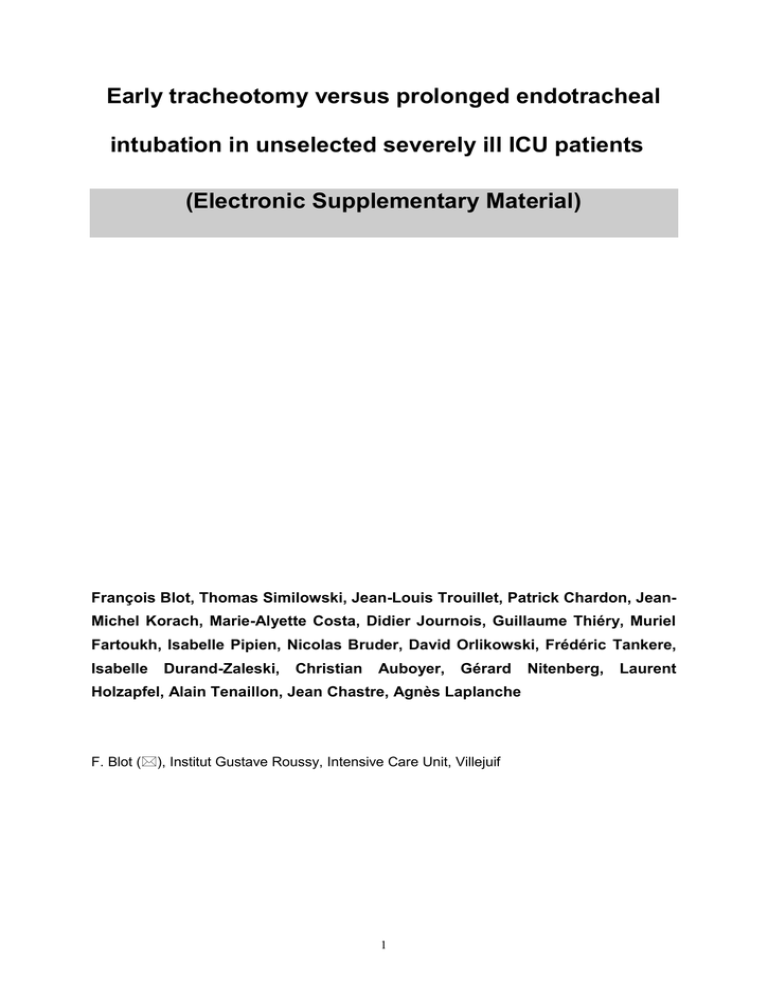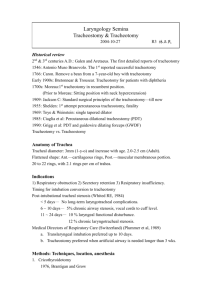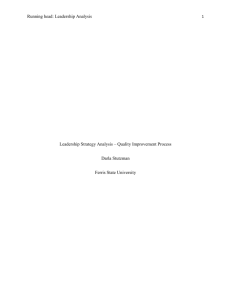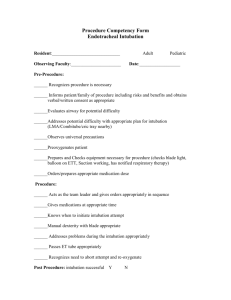Early tracheotomy versus prolonged endotracheal (Electronic Supplementary Material)
advertisement

Early tracheotomy versus prolonged endotracheal intubation in unselected severely ill ICU patients (Electronic Supplementary Material) François Blot, Thomas Similowski, Jean-Louis Trouillet, Patrick Chardon, JeanMichel Korach, Marie-Alyette Costa, Didier Journois, Guillaume Thiéry, Muriel Fartoukh, Isabelle Pipien, Nicolas Bruder, David Orlikowski, Frédéric Tankere, Isabelle Durand-Zaleski, Christian Auboyer, Gérard Holzapfel, Alain Tenaillon, Jean Chastre, Agnès Laplanche F. Blot (), Institut Gustave Roussy, Intensive Care Unit, Villejuif 1 Nitenberg, Laurent Patients and methods Exclusion criteria: Patients were excluded if they 1. had previously been enrolled in the trial; 2. had been or were already tracheotomised; 3. had a major risk of bleeding (platelet count <50 000/mm3, prothrombin time >1.5 times,...); 4. had a soft tissue infection of the neck; 5. had an anatomical deformity of the neck; 6. had undergone a sternotomy <15 days; 7. were suffering from well established chronic obstructive or restrictive respiratory insufficiency; 8. had an irreversible neurological disease; 9. had post-trauma intra-cranial hypertension (intracranial pressure > 20 cm H2O and/or cerebral oedema on head CT scan); 10. had a poor chance of survival, as defined by a Simplified Acute Physiology Score (SAPS II [12]) of more than 80 points and/or a number of organ failures (OSF [13]) exceeding 4; or 11. if a decision had been reached to limit care. Ventilation, weaning and sedation protocol In both groups, weaning off MV was conducted according to a strict study protocol. Weaning criteria were defined as follows: improvement in or resolution of the underlying cause of acute respiratory failure; SaO2>90% with a fraction of inspired oxygen (FiO2) <40% and a positive end-expiratory pressure of <5 cm of water; a core temperature below 38°5C; correction of electrolytic disorders; a good level of consciousness; and no further need for high doses of vasoactive and sedative agents. Patients fulfilling these criteria underwent a trial of spontaneous breathing lasting up to two hours, and were finally extubated (PI group) or placed on a tracheotomy collar (ET group, or secondarily tracheotomised). If they met poor tolerance criteria (respiratory rate > 35 per minute or increased by 50%, use of accessory respiratory muscles, diaphoresis, heart rate or blood pressure increased by >20% or alteration of consciousness), assist-control ventilation was first reinstituted and two weaning strategies were proposed : daily T-piece trials or pressure support ventilation (PSV), as recommended [14]. When weaning criteria were obtained, the patients were extubated or 2 placed on a tracheotomy collar. Even if there were no signs of distress by the end of this trial, extubation could be postponed for a maximum of 24 hours if the primary physician felt a patient might not be able to evacuate secretions or protect the airway against aspiration. Weaning was considered to have failed if reintubation was necessary within 48 hours after extubation, and a single episode of MV was recorded. End-points and follow-up The primary end-point was death at 28 days. Secondary end-points included d-28 incidence of ICU-acquired pneumonia, the duration of MV during the first 28 days, the day-60 mortality rate, hospital mortality rate, the total duration of MV, infectious complications (other than pneumonia) during the first 28 days, early laryngeal and tracheal complications, sedation requirements during the first 28 days and comfort of patients. ICU-acquired pneumonia Respiratory secretion samples were obtained at the attending physician’s request when a new episode of ICU-acquired pneumonia was clinically suspected. Clinical suspicion of pneumonia was based on classic criteria [19] (chest radiograph, fever, leukocytosis, purulent tracheal secretions or gas exchange alterations ). The diagnosis of pneumonia was established when clinical criteria were confirmed by positive quantitative cultures of pulmonary secretion samples, obtained within 24 h of clinical suspicion : depending on the investigator’s habits, bronchoalveolar lavage (significant threshold 104 colony-forming units/mL) [20], protected specimen brush or catheter ( 103 colony-forming units/mL) [21, 22] and quantitative tracheal aspirate ( 106 colony-forming units/mL) [23] were allowed. In patients who could not provide pulmonary samples (e.g. unstable respiratory condition after extubation or removal of the cannula), any introduction of antibiotics for 48 hrs or more for suspicion of pneumonia (without another remote focus of infection) was considered as possible pneumonia. Infectious complications (other than pneumonia) 3 Episodes of bloodstream infections were recorded during the first 28 days. One positive blood culture was required for the diagnosis of significant bacteraemia, except for coagulase negative Staphylococci and other skin contaminants (for which two positive blood cultures were required). Stomal complications were recorded for patients who underwent an early or late tracheotomy : local inflammation, significant infection at the stomal site, antibiotic requirements, as well as haemorrhagic complications requiring blood transfusion or surgery. Results Outcome measures Mechanical ventilation, endotracheal prosthesis: reintubation, secondary tracheotomy and type of procedure Tracheotomy offers the benefit of reconnecting the ventilator after spontaneous breathing trial (SBT) failure. The number of reintubations was 15 in the PI group : 5 after accidental extubation, 10 after a successful SBT, one half of which were secondarily converted to tracheotomy. Sixteen patients in the PI group were finally tracheotomised, three-fourths of them after d14 as stipulated in the protocol (median [range] delay of 15 [5-32 days]). The incidence of complications (pneumonia, maxillary sinusitis and bloodstream infections) was compared between these patients and the 46 patients who did not undergo tracheotomy. There was an increased incidence of each complication, but none was statistically significant. The number of complications was also examined between open and percutaneous tracheotomy procedures. In the ET group, 19 had a percutaneous procedure and 41 a surgical procedure (1 patient died before tracheotomy). The incidence of complications was similar in these 2 subgroups. 4 Figure 3. Percentages of patients on mechanical ventilation during the first 28 days 100% Tracheotomy Intubation 80% 60% 40% logrank, p = 0.54 20% Days from randomisation 0% At risk at risk 0 4 8 61 62 57 59 50 53 12 36 41 16 29 33 5 20 23 25 24 18 21 28 15 16 Figure 4. Cumulative incidence of ICU-acquired pneumonia during the first 28 days 100% 80% 60% 40% Tracheotomy Intubation 20% logrank, p = 0.94 Days from randomisation 0% 0 4 8 61 62 48 51 41 38 12 16 20 24 28 9 8 6 7 At risk 30 25 19 20 6 12 14 Figure 5. Random effects meta-analysis of relative risk (95% confidence interval) of mortality with early tracheotomy compared with prolonged intubation. Study Bouderka et al 2004 Rodriguez et al 1990 Rumbak et al 2004 Saffle et al 2002 Blot et al 2008 Early tracheostomy n/N Late tracheostomy n/N 12/31 9/51 19/60 4/21 21/61 7/31 13/55 37/60 6/23 20/62 224 Total (95% CI) Total events: 65 (Early tracheostomy), 83 (Late tracheostomy) Test for heterogeneity: Chi² = 9.17, df = 4 (P = 0.06), I² = 56.4% Test for overall effect: Z = 0.73 (P = 0.47) RR (random) 95% CI 17.26 17.95 28.14 11.14 25.52 231 100.00 0.1 0.2 0.5 Favours early 7 Weight % 1 2 5 Favours late 10 RR (random) 95% CI 1.71 0.75 0.51 0.73 1.07 [0.78, [0.35, [0.34, [0.24, [0.65, 3.77] 1.60] 0.78] 2.23] 1.76] 0.85 [0.54, 1.32] Figure 6. Random effects meta-analysis of relative risk (95% confidence interval) of hospital-acquired pneumonia with early tracheotomy compared with prolonged intubation. Study Bouderka et al 2004 Dunham et al 1984 Rodriguez et al 1990 Rumbak et al 2004 Saffle et al 2002 Blot et al 2008 Early tracheostomy n/N Late tracheostomy n/N 18/31 20/34 40/51 3/60 21/21 30/61 19/31 20/40 53/55 15/60 22/23 31/62 RR (random) 95% CI Weight % 14.88 14.59 24.30 3.43 26.10 16.70 258 271 Total (95% CI) Total events: 132 (Early tracheostomy), 160 (Late tracheostomy) Test for heterogeneity: Chi² = 24.58, df = 5 (P = 0.0002), I² = 79.7% Test for overall effect: Z = 0.67 (P = 0.50) 100.00 0.1 0.2 0.5 Favours early 8 1 2 5 Favours late 10 RR (random) 95% CI 0.95 1.18 0.81 0.20 1.05 0.98 [0.63, [0.77, [0.70, [0.06, [0.96, [0.69, 1.43] 1.79] 0.95] 0.66] 1.14] 1.40] 0.92 [0.73, 1.17] Figure 7. Random effects meta-analysis of relative risk (95% confidence interval) of duration of mechanical ventilation in days, with early tracheotomy compared with prolonged intubation. Study N Bouderka et al 2004 Rodriguez et al 1990 Rumbak et al 2004 Saffle et al 2002 Blot et al 2008 31 51 60 21 61 Early tracheostomy Mean (SD) 14.50(7.30) 12.00(7.14) 7.60(4.00) 35.50(20.62) 16.00(9.00) 224 Total (95% CI) Test for heterogeneity: Chi² = 53.28, df = 4 (P < 0.00001), I² = 92.5% Test for overall effect: Z = 1.96 (P = 0.05) N 31 55 60 23 62 Late tracheostomy Mean (SD) WMD (random) 95% CI 17.50(10.60) 32.00(22.25) 17.40(5.30) 31.40(24.94) 16.00(8.00) 21.63 19.79 23.82 11.77 23.00 231 100.00 -100 -50 Favours early 9 Weight % 0 50 Favours late 100 WMD (random) 95% CI -3.00 -20.00 -9.80 4.10 0.00 [-7.53, 1.53] [-26.20, -13.80] [-11.48, -8.12] [-9.38, 17.58] [-3.01, 3.01] -6.46 [-12.91, 0.00] Table 5. Characteristics of Mechanical Ventilation and Organ System Failures at the time of randomisation, n (%) Previous episode of MV: invasive / noninvasive MV Causes of MV : Respiratory failure - ARDS - Pneumonia - Cardiogenic pulm.oedema - COPD - thoracic trauma - other Haemodynamic failure Neurological Failure Cardiac arrest Intubation route : oral / nasal route Radiological score PaO2/FiO2 * PaCO2 (mmHg) * PEEP cmH20 * Antibiotic or antifungal therapy Duration* of MV at the time of randomisation (days) : Number of organ failures 1 2 3 4 Type of organ failures - respiratory - circulatory - neurological - renal - haematological - hepatic SAPS II* * median (range) 10 Early tracheotomy (n=61) 11 (18) 6 /6 49 (80) 13 9 2 4 9 12 27 (44) 27 (44) 0 58 / 3 4 208 38 6 46 (95 / 5) (0-10) (47-660) (24-73) (2-12) (75) 2 (0-4) Prolonged intubation (n=62) 10 (16) 6 /5 51 11 14 0 4 8 14 24 27 3 57 / 5 5 184 41 6 50 (82) (39) (44) (5) (92 / 8) (0-12) (63-465) (23-72) (2-16) (81) 2 (0-4) 10 31 13 7 (16) (51) (21) (11) 12 31 17 2 (19) (50) (27) (3) 61 31 26 14 4 3 47 (100) (51) (43) (23) (7) (5) (19-76) 62 29 23 13 2 4 43 (100) (47) (37) (21) (3) (6) (19-80) Table 6 : Tracheotomy characteristics of patients with early tracheotomy or prolonged intubation, n (%) Early tracheotomy (n=61) 60 (98) Prolonged intubation (n=62) 16 (26) Tracheotomy 1 Time between randomisation and tracheotomy (days) * 0 (0-6) 15 (5-32) 0-2 58 0 3-6 22 2 7 - 28 0 10 29 - 60 4 Cause of tracheotomy Randomisation arm 60 (100) Extubation failure 3 (19) Prolonged MV 11 (69) Other 2 (12) Procedure performed in the: Intensive care unit 52 (87) 13 (81) Operating room 8 (13) 3 (19) Operator Intensivist 37 (62) 11 (69) Surgeon / ENT 23 (38) 5 (31) Technique Surgical 41 (68) 9 (56) Percutaneous 19 (32) 7 (44) * median (range) 1 Early tracheotomy group: 1 death before tracheotomy Intubation group: 16 delayed tracheotomies (12 within the first 28 days, 4 between d28 and d60) 2 One patient was successfully tracheotomised on d6 (2nd attempt) 11 Table 7 (3-bis). Late airway assessment of patients with early tracheotomy or prolonged intubation Early tracheotomy (n=61) Late assessment (two months) : alive pts Late assessment performed At least one symptom * - Swallowing troubles - Dysphonia - Laryngeal dyspnea - Tracheal dyspnea Laryngeal examination performed At least one sign - Abnormal arytenoid mobility - Abnormal vocal cord mobility - Laryngeal oedema - Post-intubation laryngeal granuloma - Post-intubation vocal cord ulceration Tracheal examination performed At least 1 sign (stenosis and granuloma) * Chi-2 : NS ** (n): severe complications; 12 43 13 1 0 1 0 0 13 3 1 1 2 0 1 5 1 (30%) (8%) (30%) (25%) (12%) (20%) Prolonged intubation (n=62) 43 12 7 2 5 0 0 12 3 0 0 2 1 0 2 0 (28%) (58%) (1) ** (28%) (25%) (1) ** (5%) (0%)

![Chester _Royals_FCOT[1]](http://s3.studylib.net/store/data/006762869_1-d0409422479a6dd3b4d6752fba5dcd6e-300x300.png)

